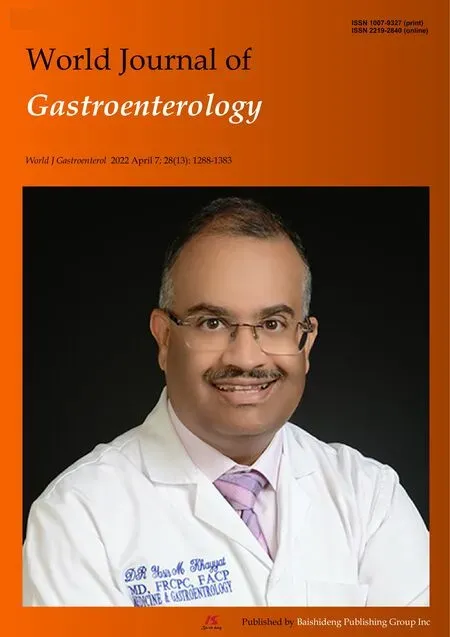Endoscopic resection for early gastric cancer: Towards a global understanding
Alba Panarese
Abstract Gastric cancer is widespread globally, and disease diagnosis is accompanied by high mortality and morbidity rates. However, prognoses and survivability have improved following implementation of surveillance and screening programs,which have led to earlier diagnoses. Indeed, early diagnosis itself supports increased surgical curability, which is the main treatment goal and guides therapeutic choice. The most recent Japanese guidelines for endoscopic submucosal dissection and endoscopic mucosal resection for early gastric cancer consider the degree of endoscopic curability in relation to the characteristics of the gastric lesions. In clinical practice, the management approach for both prevention and treatment should be similar to that of colon lesions; however, unlike the established practices for colorectal cancer, the diagnostic and therapeutic pathways are not shared nor widespread for gastric cancer. Ultimately, this negatively impacts the opportunity to perform an endoscopic resection with curative intent.
Key Words: Early gastric cancer; Artificial intelligence; Malignancy; Helicobacter pylori;Autoimmune gastritis; Dysplasia
TO THE EDITOR
The review by Younget al[1 ], which offers a broad overview of endoscopic diagnosis and treatment of gastric dysplasia and early cancer with the prospect of future implications, was received with great interest. The authors reported that endoscopic treatment of precancerous lesions and early gastric cancer reduces rates of advanced carcinoma and avoids the requirement for surgery. However, there are relevant differences between the East and West for data related to the practice of endoscopic resection and the histological definitions of lesions[1 ].
Gastric cancer accounts for a significant proportion of cancer-related morbidity and mortality worldwide[2 ,3 ], and early detection is required to reduce the rates of each. The risk of progression from low-grade and high-grade dysplasias detected by biopsy to gastric cancer is high. For this reason,guidelines suggest endoscopic removal of any dysplastic lesion[4 ,5 ]. However, the incidence of early gastric cancer differs among countries, particularly for those in the Eastern and Western regions of the world[2 ,3 ,6 ]. In European countries, for example, early-stage gastric cancer accounts for less than 10 % of diagnosed cases, which is much less than that in Asian countries where endoscopic screening is practiced. It has been reported that endoscopic screening may reduce the risk of death from gastric cancer without affecting gastric cancer incidence[7 ]. In fact, in the East, gastric cancer screening programs allow early diagnosis and consequently increase the curability of subsequent treatment by surgical resection. Likewise, endoscopic resection allows endoscopic curability, and through these collective clinical efforts, morbidity and mortality of gastric cancer can continue to decrease[3 ].
Therefore, advances in endoscopic imaging and resection techniques as well as improved endoscopist training are very important. Yet the maximal benefits will only be realized if these efforts are carried out alongside expanded implementation of screening and surveillance gastroscopies because gastric cancer originates from precancerous lesions. Intriguingly, this pathogenic pattern is similar to that of colon cancer, whereby the cancer arises from polypoid and non-polypoid lesions of the colon[8 ].
Our ongoing Italian multicenter prospective observational study on endoscopic submucosal dissections of early gastric cancer has, so far, enrolled 32 cases in 18 mo in 12 centers. A comparison with other studies is not possible at this time for several reasons, namely among them unavoidable alterations to the clinical routine caused by the coronavirus disease 2019 pandemic. However, it appears that in addition to technological and diagnostic advances and improved skills of endoscopists, the presence of screening programs could be important to further identify and enroll patients who are atrisk. This represents a similar trend to that experienced in the colon cancer screening programs.
The ongoing high incidence of gastric cancer, especially in the youngest generations, due to the persistent spread ofHelicobacter pylori(H. pylori) infection, makes gastric cancer a major public health challenge. Currently, the mortality rate for total gastric cancer deaths is higher than that of either breast cancer or colon cancer[3 ,9 ]. Since it is important to achieve a common vision for eradicatingH. pylorion a global scale, the additional application of bothH. pyloriantibody titer and pepsinogen levels together may further promote the effectiveness of gastric cancer screening programs[10 ].
The new Japanese Guidelines for Endoscopic Submucosal Dissection and Endoscopic Mucosal Resection for Early Gastric Cancer (Second Edition)[11 ] define the indications for endoscopic treatment in relation to curability and according to the risk of lymph node metastases, based on current scientific evidence. Absolute, expanded and relative indications for the endoscopic treatment of gastric lesions and levels of curability (“endoscopic curability A: curative resection,” “endoscopic curability B” and“endoscopic curability C”)[11 ] are the starting point for prospective confirmatory studies in both Eastern and Western countries. These studies should determine the 5 -year survival when these screening programs are implemented.
FOOTNOTES
Author contributions:Panarese A conceived, designed, wrote and revised the manuscript.
Conflict-of-interest statement:None to declare.
Open-Access:This article is an open-access article that was selected by an in-house editor and fully peer-reviewed by external reviewers. It is distributed in accordance with the Creative Commons Attribution NonCommercial (CC BYNC 4 .0 ) license, which permits others to distribute, remix, adapt, build upon this work non-commercially, and license their derivative works on different terms, provided the original work is properly cited and the use is noncommercial. See: https://creativecommons.org/Licenses/by-nc/4 .0 /
Country/Territory of origin:Italy
ORCID number:Alba Panarese 0000 -0002 -6931 -2171 .
S-Editor:Fan JR
L-Editor:A
P-Editor:Fan JR
 World Journal of Gastroenterology2022年13期
World Journal of Gastroenterology2022年13期
- World Journal of Gastroenterology的其它文章
- Therapeutic drug monitoring in inflammatory bowel disease: At the right time in the right place
- Generic and disease-specific health-related quality of life in patients with Hirschsprung disease: A systematic review and meta-analysis
- Locoregional therapies and their effects on the tumoral microenvironment of pancreatic ductal adenocarcinoma
- Increased prognostic value of clinical–reproductive model in Chinese female patients with esophageal squamous cell carcinoma
- Comparison of the performance of MS enteroscope series and Japanese double- and single-balloon enteroscopes
- Management of incidentally discovered appendiceal neuroendocrine tumors after an appendicectomy
